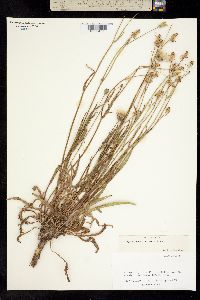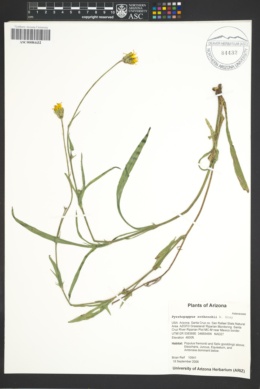Pyrrhopappus rothrockii
|
|
|
|
Family: Asteraceae
|
Perennials (possibly flowering first year), 15-40 cm. Stems seldom, if ever, scapiform, branching from bases and/or distally, glabrous or pilosulous proximally. Cauline leaves (1-)3-9+, proximal mostly spatulate or oblanceolate to linear, margins entire, dentate, or pinnately lobed, distal usually narrowly lanceolate to lance-attenuate, margins usually entire or with 1-2 lobes near bases, sometimes pinnately 3-5(-7+)-lobed. Heads (1-)3-5+ in loose, corymbiform arrays. Calyculi: bractlets 3-5+ in 1-2 series, deltate to subulate, 2-5 mm. Involucres ± cylindric, 12-15(-20+) mm. Phyllaries 13-16+. Florets (20-)30-60+; anthers 3.5-4 mm (pollen equatorial diameters unknown). Cypselae: bodies stramineous, 3-4 mm, beaks 6-7 mm; pappi 6-7 mm. 2n = 12. Flowering May-Sep. Meadows, stream banks, flood plains; 1100-2700 m; Ariz., N.Mex., Tex. For the present, I concur with D. K. Northington (1974) and I treat Pyrrhopappus rothrockii as distinct from P. pauciflorus.
FNA 2006 Duration: Perennial Nativity: Native Lifeform: Forb/Herb General: Herbaceous perennials, to 40 cm tall, stems seldom, if ever, scapiform, branching from the bases and/or distally, surfaces glabrous or lightly pilose proximally. Leaves: Proximal blades mostly spatulate or oblanceolate to linear, margins entire, dentate, or pinnately lobed, distal blades usually narrowly lanceolate to lance-attenuate, margins usually entire or with 1-2 lobes near the bases, sometimes pinnately 3-5 lobed (or more), distal blades sometimes sessile, basal blades usually petiolate. Flowers: Heads showy with yellow ray flowers only; florets 20-60 or more, anthers 3.5-4 mm long, phyllaries 13-16 or more, involucres cylindric, 12-20 mm high or more, receptacles convex, pitted, glabrous, epaleate, calyculi with 3-5 or more bractlets in 1-2 series, these deltate to subulate, 2-5 mm long, heads borne in groups of 1-5 or more in loose, corymbiform arrays. Fruits: Cypselae 3-4 mm long with beaks 6-7 mm long, surfaces stramineous, grooves or broad ribs 5, glabrous. Pappi 6-7 mm long, borne on discs at tips of beaks, persistent, double; the outer coroniform and of whitish, relatively short, spreading, sometimes curly Ecology: Found in meadows, stream banks, and flood plains, from 3,500-9,000 ft (1067-2743 m); flowering May-September. Distribution: Arizona, New Mexico, Texas. Notes: The yellow flowers with only rays (no disks) are a good indicator for the genus. Ethnobotany: Unknown, but other species in the genus have uses. Etymology: The meaning of Pyrrhopappus is unknown, and rothrockii is named after Dr. Joseph Trimble Rothrock (1839-1922), professor of botany at the University of Pennsylvania and surgeon on the Wheeler Exploring Expedition of 1873-1875. Synonyms: Sitilias rothrockii Editor: LCrumbacher2012 |















